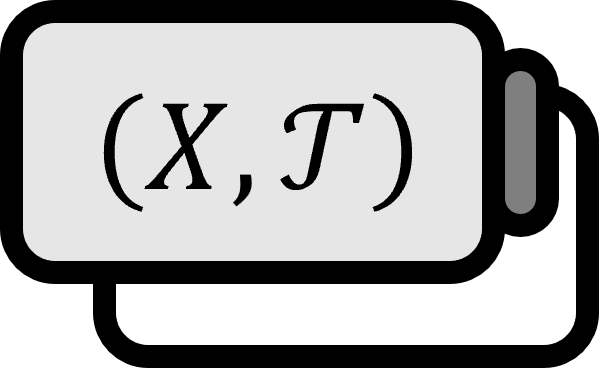What are Successive Properties in Topology?
Buildup: Subspaces
Let’s say for a topological space $(X, \mathscr{T})$, $Y \subset X$.
If we set $\mathscr{T}’ := \left\{ U \cap Y \ | \ U \in \mathscr{T} \right\}$, then $(Y , \mathscr{T}’ )$ becomes a subspace of $X$ and $\mathscr{T} ' $ is called the subspace topology induced by $\mathscr{T}$ on $Y$.
- [1]: The necessary and sufficient condition for $A \subset Y$ to be a closed subset in $Y$ is that there exists a closed subset $C \subset X$ satisfying $A = C \cap Y$.
- [2]: The necessary and sufficient condition for $N \subset Y$ to be a neighborhood of $y \in Y$ in $y$ is that there exists a neighborhood $N ' \subset X$ of $y$ satisfying $N = Y \cap n '$.
It is important to note that the newly formed subspace topology does not guarantee to have the properties of the original space. Thus, the following concept is inevitably considered.
Definition
For a topological property $P$ on $X$, if all subspaces of $X$ have the property $P$, then $P$ is called a Hereditary property.
Examples of hereditary property include:
- (1): First countability
- (2): Second countability
- (3): Metrizability
- (4): Hausdorff
While the nature of seeking generalization may well be inherent to mathematicians, it doesn’t necessarily answer the question of ‘is it necessary?’ However, if a theorem proven for the whole also applies to its parts, then it obviously becomes more efficient and necessary to study the whole rather than the parts. The issue of whether properties of the whole are retained in its parts is arguably one of the most important reasons for studying mathematics.
Conversely, non-hereditary properties are worth considering as counterexamples. Properties that are topological yet not hereditary include:
- (-1): Separability
- (-2): Connectedness
Counterexamples
(-1)
Let’s show a counterexample that is topological but not hereditary.
Consider the subset of $\mathbb{R}^{2}$ $$ X = \left\{ (0,1) \right\} \cup \left\{ (x,0) \ | \ x \in \mathbb{R} \right\} \\ \mathscr{T} = \left\{ \emptyset \right\} \cup \left\{ U \ | \ (0,1) \in U \subset X \right\} $$ it becomes a topological space on $\left( X , \mathscr{T} \right)$, and the subset $$ Y = \left\{ (0,1) \ | \ x \in \mathbb{R} \right\} \subset X $$ can form the subspace $\left( Y , \mathscr{T} ' \right)$. According to the definition of $\mathscr{T}$, for all $U \subset \mathscr{T}$, $$ \left\{ (0,1) \right\} \cap U \ne \emptyset $$ hence, $\left\{ (0,1) \right\}$ is dense in $X$. Since the singleton set $\left\{ (0,1) \right\}$ is countable, $X$ is a separable space. On the other hand, $$ Y = \left\{ (x, 0) \ | \ x \in \mathbb{R} \right\} \subset X $$ forms the subspace $\left( Y, \mathscr{T} ' \right)$. However, $$ \mathscr{T} ' = \left\{ U \cap Y \ | \ U \in \mathscr{T} \right\} = \mathscr{P} (\mathbb{R}) = \mathscr{P} (Y) $$ In other words, $Y$ becomes a discrete space.
Criterion for Density: The equivalence of $A$ being dense in $X$ and for every open subset $U$ of $X$, $U \cap A \ne \emptyset$ holds.
Since a discrete space is such that for every $U \in \mathscr{T} ' = \mathscr{P} (Y)$, $$ U \cap ( Y \setminus U ) = \emptyset $$ taking any countable subset $U \subset \mathscr{P} (Y)$ of $Y$, there exists an open set $U^{c} \in \mathscr{T} ' $ satisfying $U \cap U^{c} = \emptyset$, hence $U$ does not possess denseness. Therefore, $Y$ cannot be a separable space.
■
(-2)
Let’s show a counterexample that is topological but not hereditary. Considering the subset $X : = (-1,0) \cup (0,1)$ of the Euclidean space $\mathbb{R}$, the subspace $X$ of $\mathbb{R}$ becomes a disconnected space.
■
